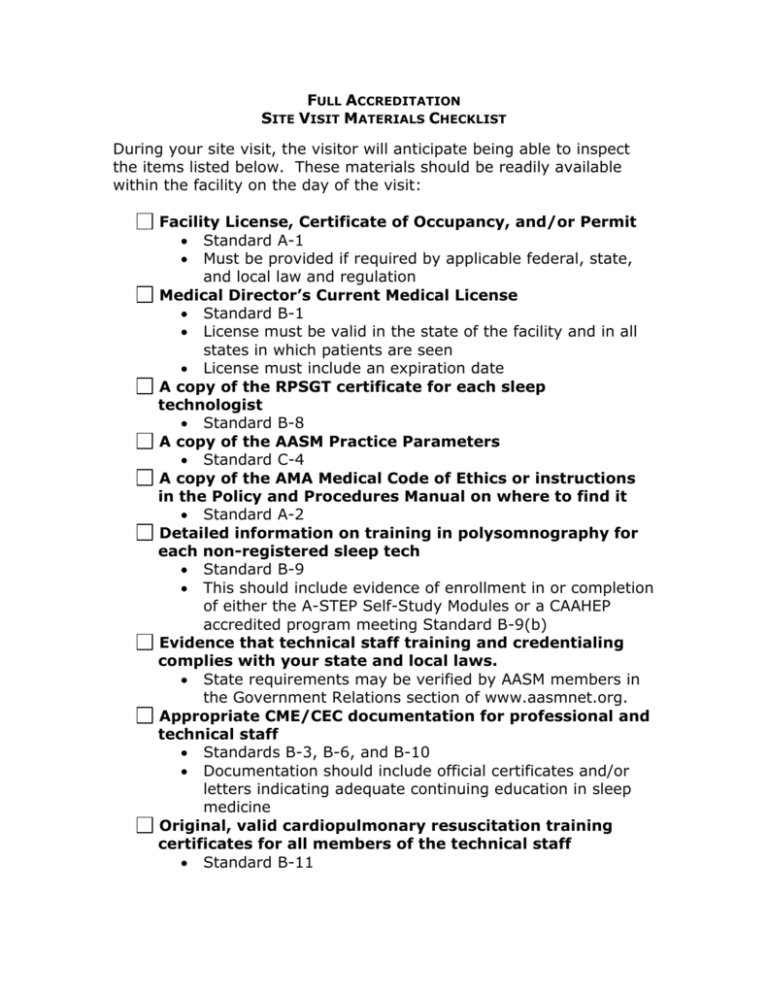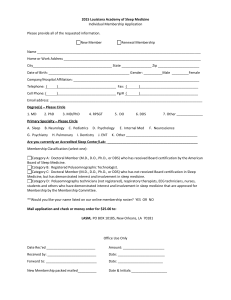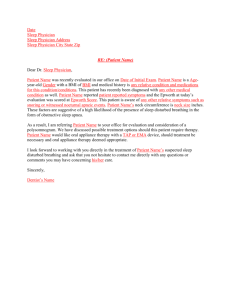FULL ACCREDITATION
advertisement

FULL ACCREDITATION SITE VISIT MATERIALS CHECKLIST During your site visit, the visitor will anticipate being able to inspect the items listed below. These materials should be readily available within the facility on the day of the visit: Facility License, Certificate of Occupancy, and/or Permit Standard A-1 Must be provided if required by applicable federal, state, and local law and regulation Medical Director’s Current Medical License Standard B-1 License must be valid in the state of the facility and in all states in which patients are seen License must include an expiration date A copy of the RPSGT certificate for each sleep technologist Standard B-8 A copy of the AASM Practice Parameters Standard C-4 A copy of the AMA Medical Code of Ethics or instructions in the Policy and Procedures Manual on where to find it Standard A-2 Detailed information on training in polysomnography for each non-registered sleep tech Standard B-9 This should include evidence of enrollment in or completion of either the A-STEP Self-Study Modules or a CAAHEP accredited program meeting Standard B-9(b) Evidence that technical staff training and credentialing complies with your state and local laws. State requirements may be verified by AASM members in the Government Relations section of www.aasmnet.org. Appropriate CME/CEC documentation for professional and technical staff Standards B-3, B-6, and B-10 Documentation should include official certificates and/or letters indicating adequate continuing education in sleep medicine Original, valid cardiopulmonary resuscitation training certificates for all members of the technical staff Standard B-11 Certification should include including cognitive and skills training Each certification card must include an expiration date Sleep Facility Letterhead Standard D-4 This letterhead should be used for office notes and sleep study reports Advertising Materials The complete Policy and Procedures Manual including the following items in particular: Policy statement specifically addressing the use and availability of the AMA Medical Code of Ethics Standard A-2 Detailed medical emergency policies and procedures Standards Section I Patient acceptance policies Standards C-1 and C-2 Protocols for each procedure performed by the facility Including nocturnal polysomnography in adults and children (if applicable), supplemental oxygen, and all other procedures as required by Standards Section E. Procedures must be in accordance with current AASM Practice Parameters. Quality assurance policy Standards Section J Inter-scorer reliability policy Standards F-7 through F-11 Equipment Monitoring and Electrical Safety Policy Standard E-4 The two most recent quarterly reports of your quality assurance program Standards F-7 though F-11 and J-1 through J-3 This reports must be signed and dated by the individual fulfilling Standard B-4 These reports must include the quarterly report for interscorer reliability and at least three other QA indicators Case samples These must include the original note from consultation with one of your sleep specialists, results of sleep studies (if any were done), and one office follow up note in which the patient was advised of the results of the study and a treatment plan was formulated. Except where noted, case samples from directly referred patients are not acceptable. Sleep related breathing disorder treated with PAP Hypersomnia evaluated with Multiple Sleep Latency Test Insomnia treated with behavioral therapy Sleep restriction, stimulus control, and/or relaxation therapy Discussion of sleep hygiene is not sufficient The patient does not need to have had a polysomnogram if not clinically indicated. Restless legs syndrome A patient with periodic leg movements during sleep but without the clinical history to support the diagnosis of RLS is not sufficient. The patient does not need to have had a polysomnogram if not clinically indicated. Direct Referrals Standard C-3 At least two examples of how direct referrals are reviewed should be available. Consultants/Associated Practitioners Section G At least two examples of otolaryngologists, psychiatrists, dentists, or other health professionals to whom your professional staff refers, if applicable






